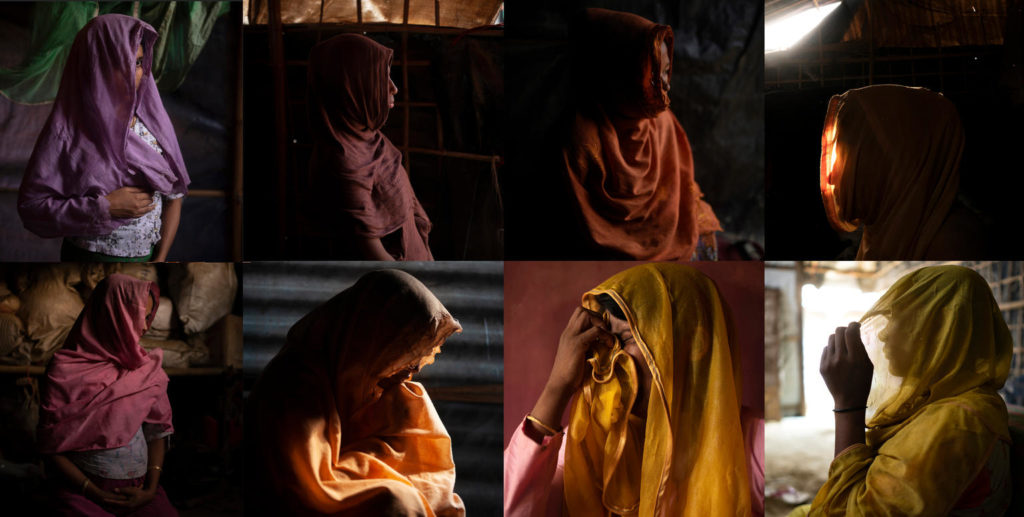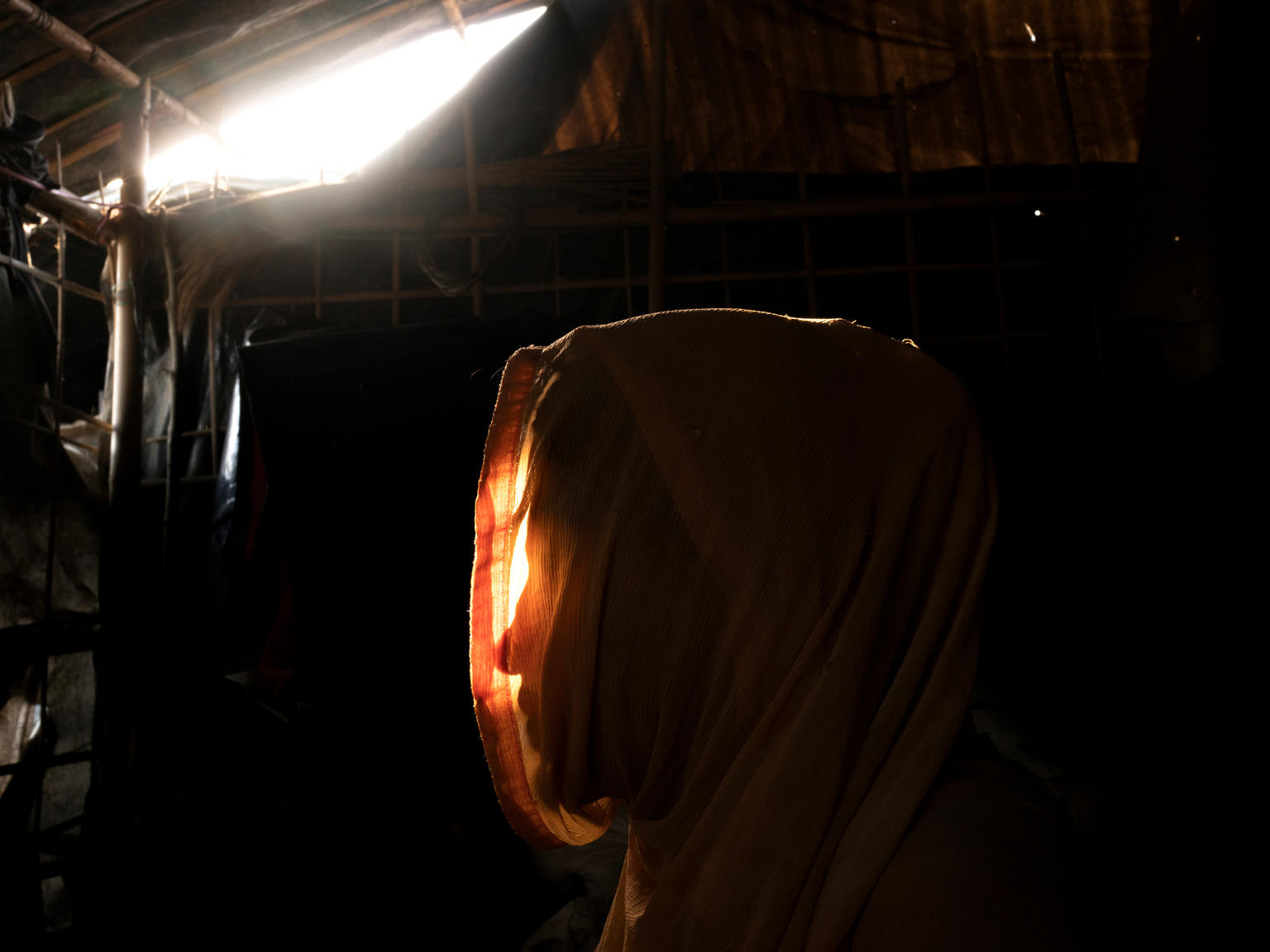Rohingya: Shrouded maternity
2018-05-28
©UNICEF/UN0207509/Sokol
Sitting in her bamboo and plastic shelter in a refugee camp in Bangladesh, "Maryam" recounts the events that forced her from her home in Myanmar following a sexual assault that left her pregnant at 16 years old. April 2018, Cox's Bazar, Bangladesh.
I look a mess. Sweat falls from my nose and wrist, dripping into my cameras. They slip in my palms and threaten to fall onto the mud floor of her orderly, if stifling, shelter.
A shaft of light shines through a hole in the plastic tarp and strikes her head scarf, framing her face in a golden glow as the call to prayer begins to echo from a distant megaphone.
She sits across from me, somehow a picture of composure amid the heat, dust and disarray. Her features are fine, her bone structure delicate. There is a child’s softness about her appearance, but not her expression. Her eyes stare unblinking into mine. She doesn’t avert them. Gradually they move, as do her hands, to the swell of her belly.
I can’t tell you her real name, but I’ll call her Maryam. She’s sixteen now, but was fifteen last year when soldiers from the Myanmar army dragged her from her home and took her to a nearby building. There, she and two other Rohingya girls were raped. She and one other survived, while the third’s throat was slit by the departing soldiers.
Maryam is one of fourteen pregnant sexual abuse survivors I’ve met, interviewed and photographed over the past two months. In fifteen years of covering conflicts, human rights violations and natural disasters around the world, I’ve never heard stories of such incomprehensible utality as I have from these women and girls.
Many of them live alone, shunned by the surviving members of their family, abandoned by their husbands or in-laws – whose responsibility their welfare becomes after marriage.
Maryam is luckier than most of the women in that she lives next to her husband’s surviving family. They continue to help her, despite the pregnancy.
Outside, my interpreter goes door to door, asking people if they would be willing to speak with a representative of UNICEF, sharing their thoughts and feelings about an upcoming cholera vaccination drive. “Were you or your children vaccinated in last year’s campaign? Do you have a private toilet in your shelter that could allow for the spread of waterborne diseases?” The questions are a ploy, intended to give an explanation for why a foreigner is speaking with people – some of them young, pregnant women – in their shelters.
If it were possible to speak with them elsewhere, I’d have done so. But other than nocturnal trips to get water, few of the women are willing to leave their cramped, unbearably hot bamboo and plastic quarters.
Maryam and I speak in hushed voices. The subject of rape, let alone a pregnancy resulting from it, is so taboo that most of the Rohingya survivors of last year’s coordinated mass sexual violence aren’t willing to acknowledge that it ever happened.

© UNICEF/UN0209329/Sokol
The survivors of sexual violence are among the most marginalised among almost 700,000 Rohingyas who were forced out of Myanmar into Bangladesh since August. Many are optimistic about the future even though some have survived extreme sexual violence.
We will never know just how many girls and women suffered these violations. Many or most of the expectant mothers themselves can’t say if the unborn children they are carrying were fathered by their husbands or by the men who raped them.
I wonder if what I’m doing is worth it. The stigma that rape carries in Rohingya society is so great that if a woman or girl is known to have been violated, her prospects for marrying – or remarrying in this case, as most of their husbands are dead or missing – become next to nil. How can a picture help Maryam? I can’t show her face, as revealing her identity puts her at risk of being even further ostracized. Does inging attention to an issue – even one this large, this heinous – justify the risk to an individual who has already endured so much? Am I commodifying her plight, or will sharing her words and her silhouetted portrait shed at least a bit of light on a topic that might otherwise remain unspoken, unseen and soon forgotten?
I gesture that Maryam should turn to the side, obscuring her eyes behind a fold of her head scarf. The beam of light strikes the right side of her face, casting a strong shadow on the glowing faic. I take several more photographs. Some closer, others from further away – showing the shadowy confines in which she spends her days. The sun dips a bit closer to the horizon and the beam of light grows faint and vanishes as the echo of prayers fade in the distance.
I ask Maryam if she would be willing to go to a hospital or clinic for prenatal checkups and delivery in a safe environment. She wouldn’t. She has a midwife who checks up on her and she’s too afraid of what people would say.
Unable to offer her anything of help, other than sharing her story with the world, I depart her shelter. Sweat drips from my sleeves and plasters my linen shirt against my torso as I walk the steep, narrow trails back to the waiting car. “Were you or your child vaccinated against cholera last year?” asks my translator. “Are you planning to take a second dose of vaccine during the upcoming campaign?”
I wish there were a vaccine against hate. I wish I didn’t have to hide what I’m doing, enshrouding faces and obscuring names. Wrapping young women in light and shadow — that it wasn’t necessary for me to be here in the first place.
“The first crime against her was the assault,” says my translator once we are away from peering eyes and wagging tongues. “The second is that she now feels the need to hide it.”
Brian Sokol is a US-born photographer, author and speaker dedicated to documenting human rights issues and humanitarian crises worldwide.










